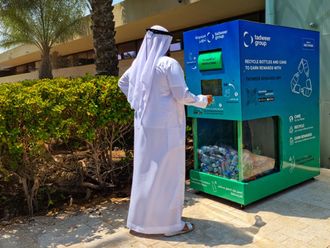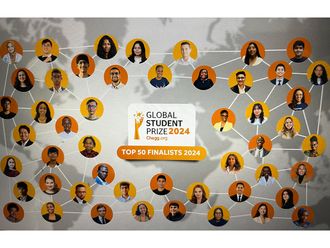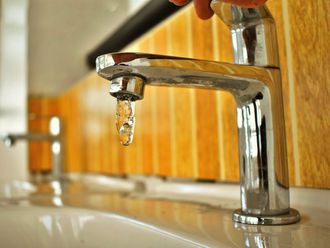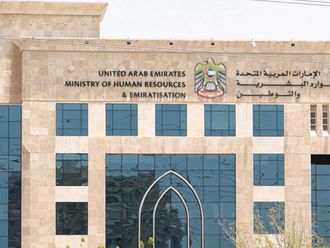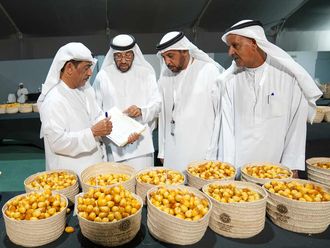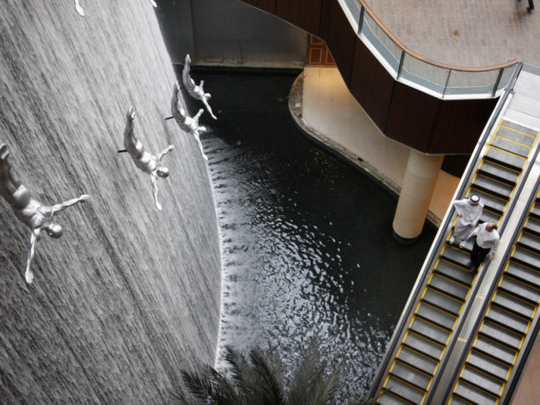
Abundance, as described in the Quran, consists of, among other things, “water whiter than snow and sweeter than honey with milk.” Increasingly, water consumption patterns for everyone from farmers to high-net-worth individuals and corporations are being seen as indicators of affluence — political, economic and social.
Dubai, a typical example of the Arabian Gulf’s coastal cities, shows off luxury in architecture. Celebrating the profusion of water in an area of scarcity are such examples as the 500-foot, $220-million (about Dh808 million) Dubai Fountain and the water clock in the Raffles Dubai lobby.
Water as luxury is now a worldwide phenomenon. Late last year, the World Luxury Fashion Week held in Abu Dhabi saw Evian’s limited-edition bottle by Diane von Furstenberg with the statement “Water is Life is Love is Life is Water is....” printed on it. Already, designers such as Issey Miyake, Paul Smith and Jean Paul Gaultier have left their imprints on the luxury bottled water segment.
Some local eateries even take pride in not serving any local water, relying on exotic bottled variations instead. Others have water menus listing 30 different bottled varieties.
Yet as a society, our approach to water is conflicted. At the other end of the spectrum sits the town of Concord in the US state of Massachusetts, which heralded the start of 2013 by banning single serving bottles of water to encourage tap use and reduce pollution from plastic bottles.
Experts insist abundant supplies are temporary and say water may soon truly be a luxury.
“Total world use of water is projected to increase by 53 per cent in 2030. The excess water that is going to be required around the world in 15 to 20 years is essentially the amount of water we are using right now,” Mark McFarland, Chief Investment Strategist at Emirates NBD Wealth Management tells GN Focus.
With per capita consumption soaring to 550 litres per year, the UAE is the world’s third-largest consumer after the US and Canada. In the US, sales of bottled water have outstripped soda as the top beverage of choice, it was reported last month. In the UAE, water is so precious, Dubai residents often point out that at Dh3 at groceries, a 1.5-litre bottle of water is only a little cheaper than a litre of petrol at Dh2.22. Over 72 per cent of the water used in the UAE comes from groundwater, which is being extracted at 23 times its recharge rate, experts pointed out at the Future Cities Conference in Dubai last October.
Investment plans
McFarland’s interest in water reflects our increasing preoccupation with long-term investment themes. “Industrial commodities were the first to reflect the dynamic growth you get in emerging markets. Agriculture and natural resources would be the next group to experience this,” he says.
He points to companies that are developing methods of irrigation, and companies involved in distribution of water resources, bottling and packing as the ones to invest in.
The politics of water
David Zetland, a senior water economist at Wageningen University in the Netherlands, says that even though politics rather than economy controls water, it may need to be priced efficiently. “In places where farmers are politically powerful they can spend tomorrow’s water today because they are allowed to do that. Soon, we will do more with less because it’s going to be expensive. We’re going to use a lot more recycled water,” he says.
Regardless of whether they want to be seen as opulent or conscientious, brands are already making statements about the resource. Jeans label Levi’s, for instance, is launching waterless jeans as part of its Spring 2013 collection. The line uses between 28 and 96 per cent less water than normal thanks to the clever combining of numerous production processes.
Water lifestyle
Dr Michael Mascha, the author of Fine Waters — A Connoisseur’s Guide to the World’s Most Distinctive Bottled Waters, who also runs Finewaters.com, is all for priced water. Only he is talking about a beverage priced as much as $30 for about half a litre.
That’s 420 Volcanic from New Zealand, described as “extremely spritzy on the palate with a tangy mineral finish”.
Explaining that water has terroir, a term borrowed from French vineyards to describe the effect of geography on taste, Dr Mascha says, “Water was once considered a commodity. This attitude is changing and water now like many other food/beverage products is considered a natural product with a source rather than something that comes from a factory.”
Water, Dr Mascha claims, can replace other beverages as a source of revenue provided hotels and retailers source well.
In terms of waters that matter, the final word belongs to David Zetland, who says luxury water has very little impact on the economics of water. “That water – like wine – is consumed for a different purpose. Worry about water for lawns, farmers and pools.”


